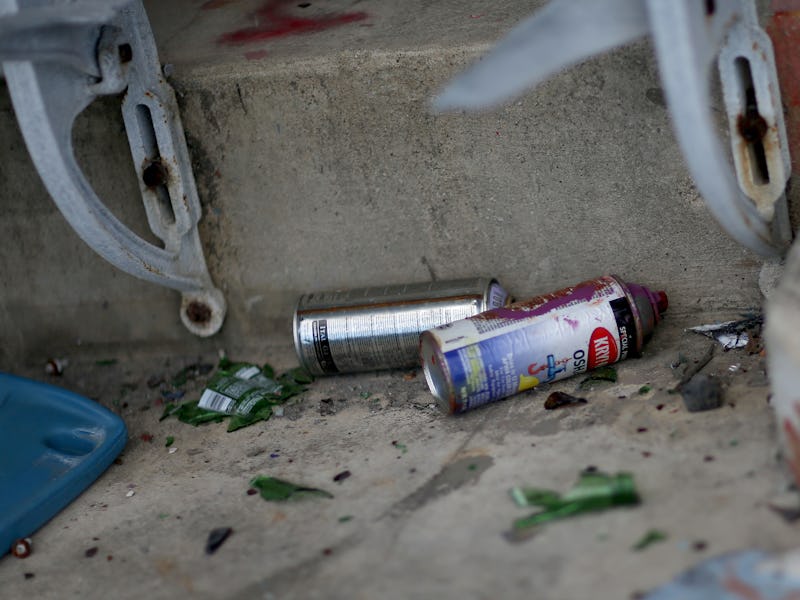How to Clean Up Racist Graffiti
There are ways to get rid of the graffiti that's been popping up since the election.

Since the election of Donald Trump, cities across the country have been reporting an uptick in incidents of racially charged graffiti appearing in public areas. Experts have pointed to the rhetoric Trump used during his campaign as a prime motivator of this resurgent behavior. Some of his most radical supporters, it seems, have taken his victory to be an endorsement of their politics by the voting public.
Of course, most people aren’t members of the groups responsible for this vandalism. Most of you probably preferred the look of your public buildings before they were defaced. Moreover, you might be looking to send a message to the people who left the graffiti by getting rid of it. So, you come across a hateful symbol or racial epithet spray painted on a wall, what do you do?
If you’d like to see it gone, you can treat this as a miniature guide to making that happen.
Call in Backup
Your first inclination might be to check if your local government can handle it. Chances are, they can. Major metropolitan areas have both systems for reporting graffiti and mechanisms for removing it. Some of them are decades old, parts of broader city beautification initiatives. New York City, Chicago, Los Angeles, and Philadelphia are among the most notable. Other iterations of these sorts of programs usually exist in smaller towns and cities as well. In some cases, graffiti-specific hotlines have been set up to ensure you speak directly to the relevant authorities, but these can be a hassle to find. It’s a surer bet that dialing 3-1-1 and asking along from there will eventually land you in the right place.
While contacting your local government is always a safe choice, it might not prove to be the most efficient. After you report the presence of graffiti, a regimented process goes into effect that, depending on where you are, could run upwards of two weeks. Oftentimes the city will notify the owner of the property in question that they have about seven to ten days to remove the graffiti themselves. If they don’t, the city can then step in to wash it off. Exceptions to this policy might be made in the case of hateful messages, but even so, if immediacy is your goal then you might want to take a different approach.
The DIY
There’s always plan B: getting your hands dirty — or clean, as it were. Plan B, however, does require some due diligence. First and foremost, be certain you feel comfortable getting in there yourself. If the graffiti is in an unsafe area, for example, it might be better off left to municipal authorities. Second, if the graffiti is on a building instead of, say, under a bridge somewhere, be sure to try and get permission to be there from whoever owns the property. The last thing you want is a misunderstanding to arise from your attempt at a good deed, or worse, the property owner could mistake you for the individual who painted the graffiti in the first place.
Something else you’ll want to consider (which might not be so obvious) is the cleaning method you choose. As much as possible, it’s good to avoid brute force techniques like power washing. Not only are they limited in their efficacy, they can potentially damage the surface you’re trying to clean. Other cleaning products you might think to try, like household paint thinners, have their own drawbacks. It’s well known that such products can have detrimental effects on the environment when they seep into runoff or groundwater. Using them outside, at scale, to remove graffiti isn’t the most responsible idea even if it does get the job done.
Ultimately, the specific products and methods you’ll want to use should depend on the type of surface you’re cleaning. There are companies out there who do make powerful, environmentally safe products for removing graffiti from a variety of materials. Doing a little research before jumping into the work should guarantee that you produce the best possible result.
Make Some Art
You could also, in lieu of erasing the graffiti, elect to paint over it. Another fine idea, but one still subject to the same environmental, legal, and practical considerations as washing it away. It could, however, be a lot more fun. The simplest version of this solution is to repaint the entire wall and turn a mean-spirited sentiment into an opportunity to deliver a visual tune-up.
For the more creative personalities, this kind of graffiti is an art project waiting to happen. If you’ve got the time, a place like Wellsville, New York, could be a great location for a mural. It’s never a bad time to transform hate into beauty.
Whatever you decide to do, achieving the know-how is the first step. The presence of graffiti affects everyone who sees it. If you’re the type to take action, take heart as well. There is plenty you can do to help.